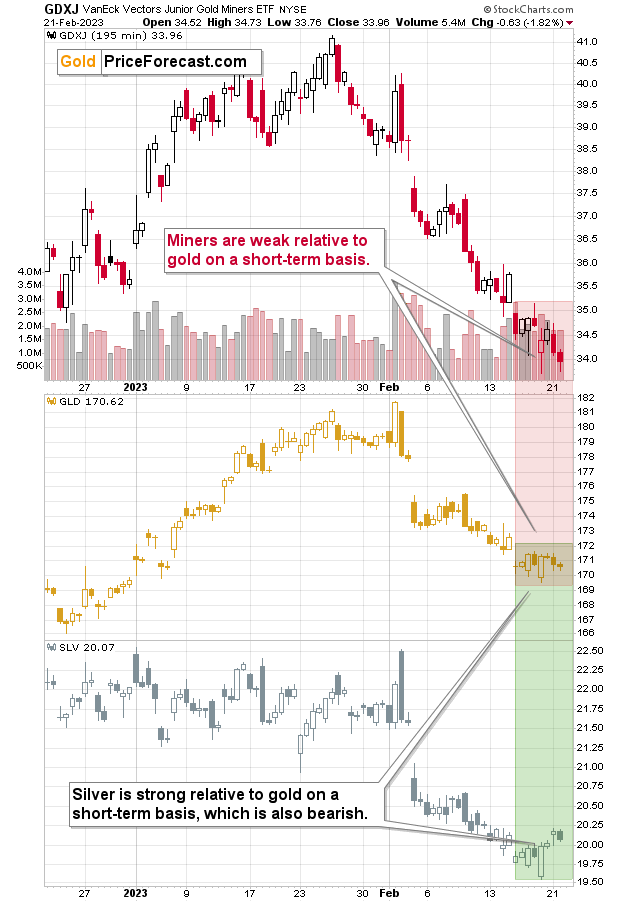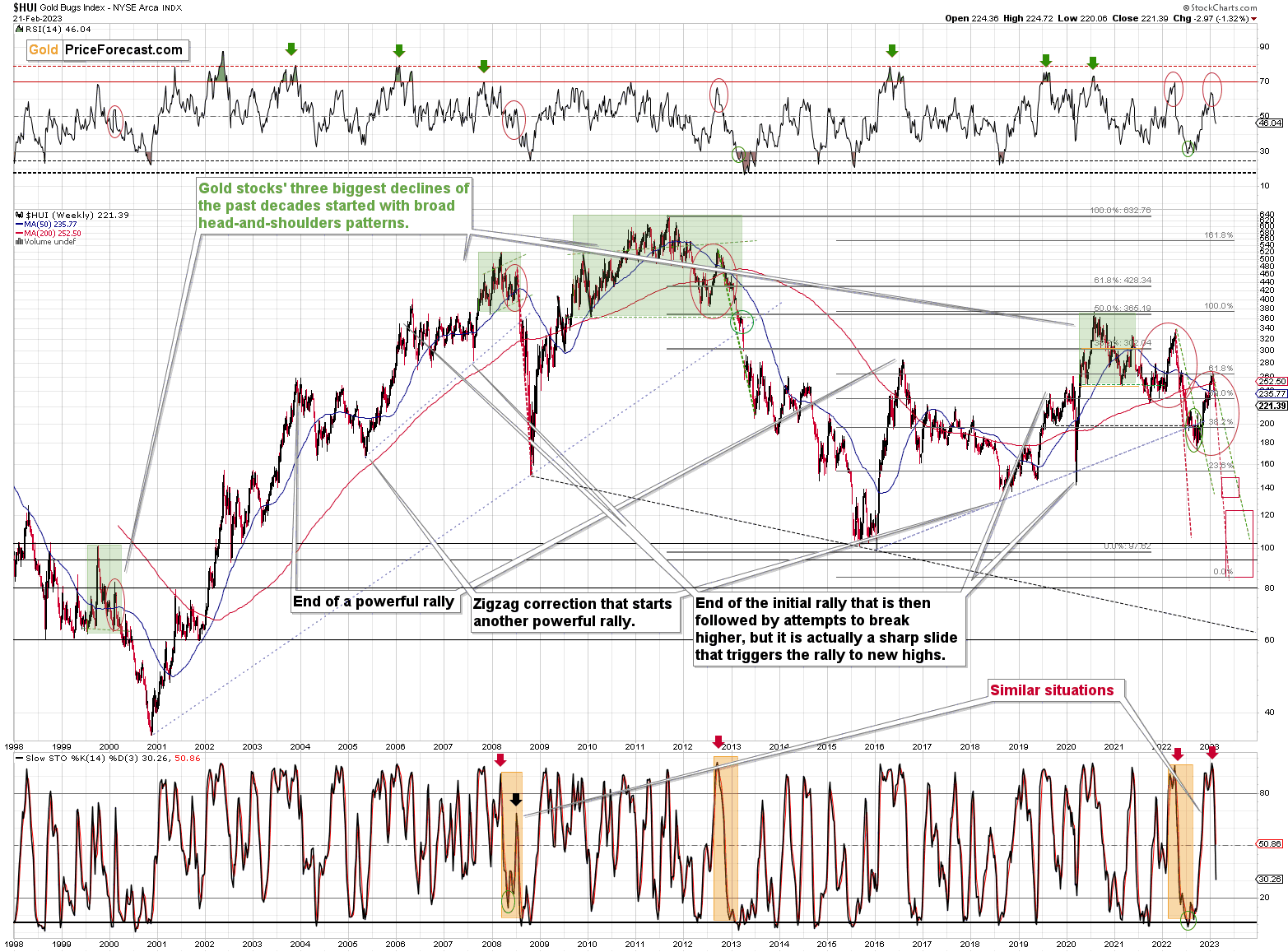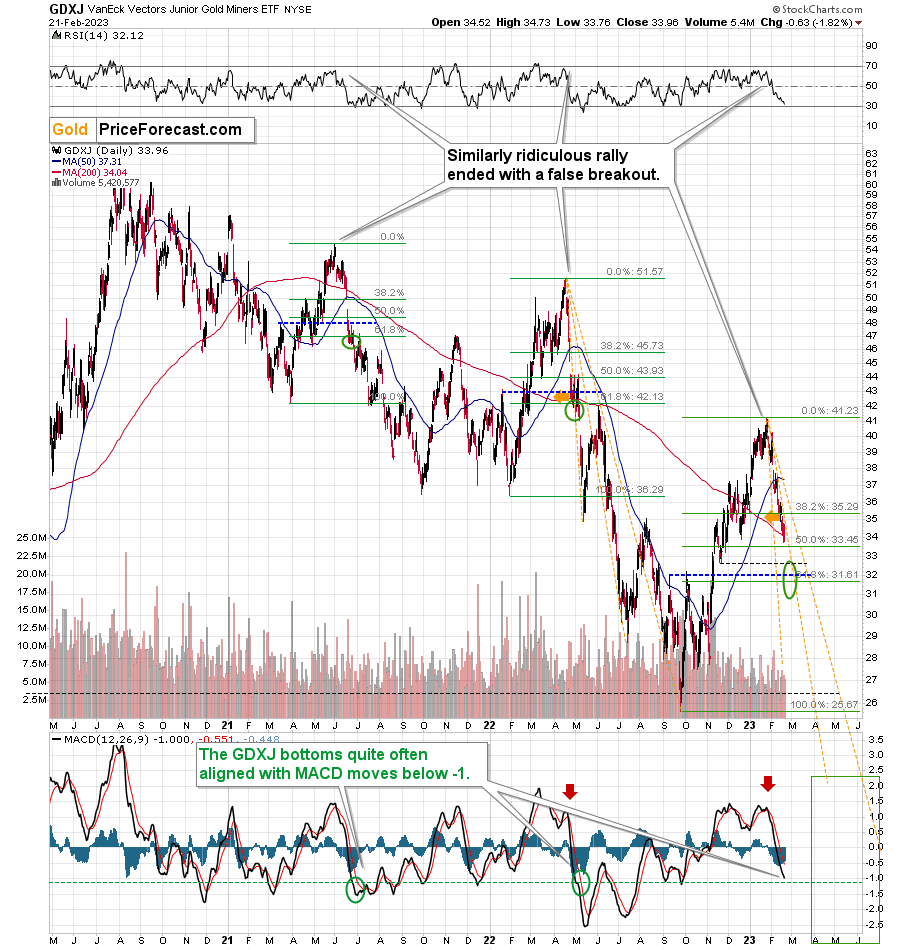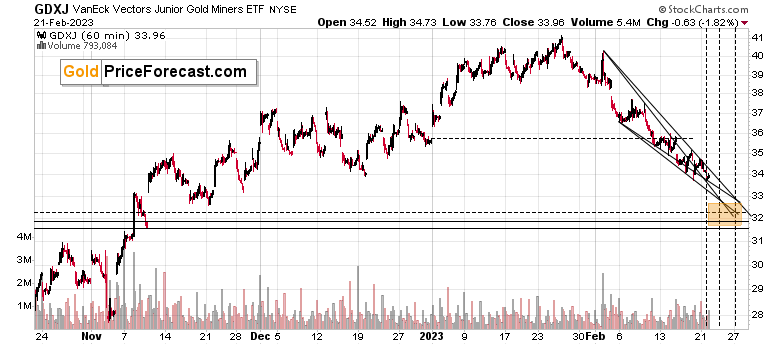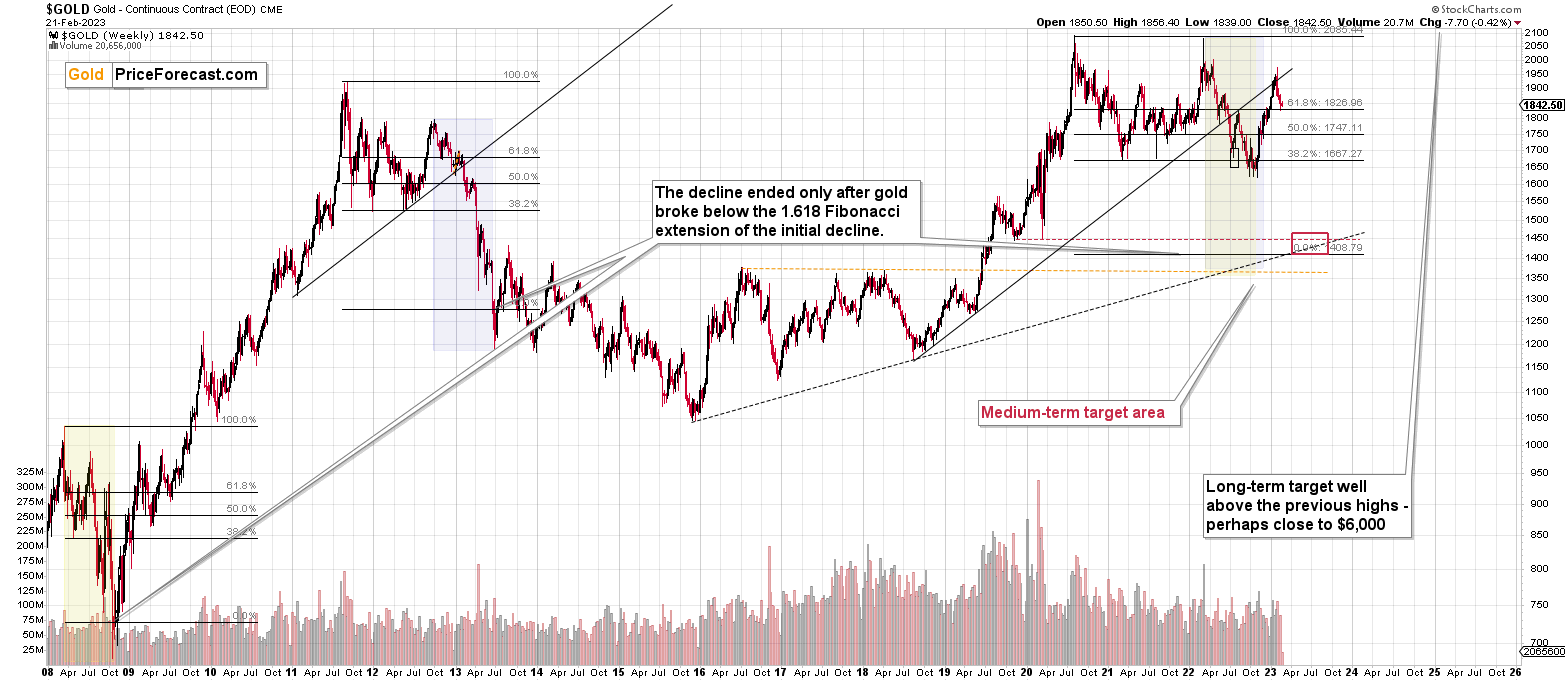Briefly: in our opinion, full (300% of the regular position size) speculative short positions in junior mining stocks are justified from the risk/reward point of view at the moment of publishing this Alert.
Gold stocks just closed at a new 2023 low! Not only that – miners declined more than gold while silver was “strong.” That’s a VERY bearish combo.
Let’s jump right into the chart that features the 4-hour candlesticks of the GDXJ ETF (a proxy for junior miners), the GLD ETF (a proxy for gold), and the SLV ETF (a proxy for silver). I’m using ETFs in all cases, so that it’s 100% clear that the price performance of all three markets is comparable. After all, continues futures contract sessions don’t end at the NYSE’s closing bell.
Remember how bullish everyone was at the beginning of the year? And when the early-February rally sparked all those “gold to $3,000!” comments? At that time – on Feb. 1 – I wrote the following:
The mining stocks are therefore underperforming gold on a short-term basis as well as on a medium-term basis. After all, the GDXJ didn’t manage to correct 61.8% of its recent decline, while gold moved above its analogous retracement.
The above means that we saw a new bearish signal when taking both into account. However, there are equally bearish indications that we saw previously and that simply remain in place.
We saw the same signal as we’ve been seeing recently – and just as it was bearish back then, it’s also bearish today.
This time, however, the short-term indications are even more bearish!
Simply put, silver joined the bearish party.
Whenever silver’s price rallies on a very short-term basis and gold’s doesn’t, or silver outperforms gold on a short-term basis in a meaningful manner, it’s a bearish indication, and it’s often followed by sizable declines in both markets.
Consequently, we have the bearish combo of weak gold stocks and relatively strong silver.
Oh, and did I mention that miners moved to fresh 2023 lows?
That may seem like a really big deal (and, in a way, it is a big deal), but when you compare the recent downswing to what could be lurking ahead, it becomes clear that “we have seen nothing yet.”
On the above chart, I used the HUI Index as a proxy, as it’s been around for a long time, and I want to put the recent move lower into proper perspective.
Gold stocks moved lower in a manner that was almost exactly as fast as what we saw in 2008. The red dashed lines show this similarity, and the green dashed lines show the analogy to the 2013 decline.
Why would those situations be similar?
The technical patterns are similar to a considerable extent (practically the only sizable difference is the early 2022 rally that’s likely based on the Russian invasion), and we even got the same kind of sell signals from the RSI (upper part of the chart) and stochastic (lower part of the chart) indicators.
On the fundamental front, we now have a perfectly bearish situation in which real rates are high and rising, and most investors appear to be oblivious to this fact. But the wake-up call will arrive, and when it does, it will likely arrive violently. Remember how the markets reacted to a different fundamental event about 15 years ago? The markets plunged in the aftermath of the subprime crisis. This time, the fundamental trigger is different, but it’s likely to hit just as hard – if not harder.
This means that gold stocks could decline really profoundly in the following months.
Will there be corrective upswings along the way? Of course! No market moves up or down in a straight line. And trading those might or might not be the best idea. Based on my research, the corrective upswings that happen early in the huge declines could still be considered “tradeable” as they are quite big, and they also take a decent amount of time to unfold (not something that changes overnight).
It's quite likely that gold, silver, and mining stocks will launch their – much more meaningful (perhaps even tradeable!) - corrective upswings this month, and the price and time targets that I had previously indicated to my Gold Trading Alerts subscribers remain up-to-date.
Namely, it seems that the GDXJ might form a short-term bottom this week (the triangle-vertex-based reversal technique points to Wednesday as the reversal day, but let’s keep in mind that this technique tends to work on a near-to basis) close to the $32 level.
The thing that I would like to add to the above today is that the short-term support and resistance lines could be created based on different price extremes, and this creates a few reversal points instead of just one. Consequently, it’s imperative to keep an eye out for price changes and act accordingly.
The target area that I added on the 1-hour chart shows that the target is not 100% precise, but that today could indeed mark the reversal day.
Consequently, what I wrote previously remains up-to-date:
Remember the triangle-vertex-reversal technique that helped us time so many tops and bottoms in the past? Here it is again.
For those who are new to it, it works pretty much as you think it would. Support and resistance lines that eventually cross create some sort of vertex, and prices tend to reverse at those moments. It doesn’t really matter if the pattern that is created by the support/resistance lines is a triangle or a wedge, or whether it’s rising, declining, or neutral. When the lines cross, the price is likely to reverse. Please note that it’s a technique for determining time, not price. So, the fact that the lines cross at a certain price is not relevant – it is the time that matters.
This technique works on a near-to basis, but it can be very accurate at times.
Right now, the support and resistance lines based on the most recent highs and lows point to a reversal in the middle of the next week – likely on or close to Wednesday, Feb. 22.
Will gold reach or move below $1,800 at that time? This seems quite likely. If they both happen at the same time and we see some bullish signs on the relative front (e.g., miners show strength relative to gold, gold shows strength relative to the USD Index), we might have a good trading opportunity to close the short position and perhaps even open a (very quick!) long one.
I will send out an intraday Gold Trading Alert if/when the opportunity to close or reverse the position emerges.
Still, please make sure that you start with yourself and plan ahead if this is something that you want to trade or not. Just because there is an opportunity out there, doesn’t mean that it’s a good idea for everyone to participate in it. Trading this upswing might be risky, as with an environment this bearish, the risk seems to be about being out of the short position, so please take this into consideration.
Overview of the Upcoming Part of the Decline
- It seems to me that the corrective upswing is over.
- If we see a situation where miners slide in a meaningful and volatile way while silver doesn’t (it just declines moderately), I plan to – once again – switch from short positions in miners to short positions in silver. At this time, it’s too early to say at what price levels this could take place and if we get this kind of opportunity at all – perhaps with gold prices close to $1,500 - $1,550.
- I plan to switch from the short positions in junior mining stocks or silver (whichever I’ll have at that moment) to long positions in junior mining stocks when gold / mining stocks move to their 2020 lows (approximately). While I’m probably not going to write about it at this stage yet, this is when some investors might consider getting back in with their long-term investing capital (or perhaps 1/3 or 1/2 thereof).
- I plan to return to short positions in junior mining stocks after a rebound – and the rebound could take gold from about $1,450 to about $1,550, and it could take the GDXJ from about $20 to about $24. In other words, I’m currently planning to go long when GDXJ is close to $20 (which might take place when gold is close to $1,450), and I’m planning to exit this long position and re-enter the short position once we see a corrective rally to $24 in the GDXJ (which might take place when gold is close to $1,550).
- I plan to exit all remaining short positions once gold shows substantial strength relative to the USD Index while the latter is still rallying. This may be the case with gold prices close to $1,400 and GDXJ close to $15 . This moment (when gold performs very strongly against the rallying USD and miners are strong relative to gold after its substantial decline) is likely to be the best entry point for long-term investments, in my view. This can also happen with gold close to $1,400, but at the moment it’s too early to say with certainty.
- The above is based on the information available today, and it might change in the following days/weeks.
You will find my general overview of the outlook for gold on the chart below:
Please note that the above timing details are relatively broad and “for general overview only” – so that you know more or less what I think and how volatile I think the moves are likely to be – on an approximate basis. These time targets are not binding nor clear enough for me to think that they should be used for purchasing options, warrants, or similar instruments.
Letters to the Editor
I received a few messages in our e-mail inbox, but I will copy-paste them to the comments feed below my premium articles (as a reminder, the “Gold Trading Alert” space on Golden Meadow is reserved to subscribers – it’s not accessible publicly) along with my replies.
Please post your questions in the comments feed below the articles, if they are about issues raised within the article (or in the recent issues), and if they are about other, more universal matters, I encourage you to use the Ask the Community space (I’m also part of the community, after all), so that more people can contribute to the reply and then enjoy the answer. Of course, let’s keep the target-related discussions in the Gold Trading Alerts space.
Summary
To summarize, in my view, the real interest rates are up and about to soar higher, the USD Index most likely bottomed and is likely to soar, while the precious metals topped in a spectacular manner and are now likely to slide – either shortly or soon enough. The rally in gold, silver, and miners was indeed sizable, but… it’s over.
What’s next? Something exciting (and, in my view, very lucrative) or something scary – depending on how positioned and informed one chooses to be.
Also, please note that (paraphrasing Sun Tzu) “understanding the enemy without understanding your true self is only half of a victory.” Before applying any insights into actionable practice (and placing or adding to your trades), please make sure that the position that you’re about to enter and its size are aligned with your approach, your investment goals, and your risk tolerance.
In other words, I suggest starting with yourself, and tailoring the trade to you, not the other way around. Please consider your motivation for this trade and how it aligns with the rest of your approach and life in general.
Hint: don’t go for the easy answer like “money” or “profits,” but consider why the result of the trade is important – is this a part of your well-designed strategy and “you have it,” or is it something you “must absolutely do” – in other words, “it has you”…).
This will save you lots of stress, which is not only end in and of itself (your happiness and health are both closely linked to your stress levels), but it also helps you become a more profitable investor as less stress (or none thereof) means more objectivity and less risk of “running for the hills” right before a given trade becomes profitable (perhaps extremely so).
Given the above, gold’s invalidation of the temporary move above its very long-term resistance (the 2011 high!), and the situation in the USD Index, it seems that the next big move lower in the precious metals sector is already underway.
Now, as more investors realize that interest rates will have to rise sooner than expected, the prices of precious metals and mining stocks (as well as other stocks) are likely to fall. In my opinion, the current trading position is going to become profitable in the following weeks, and quite possibly in the following days. While I can’t promise any kind of performance, I fully expect it to become very profitable before it’s over and to prolong our 2022 winning streak.
After the final sell-off (that takes gold to about $1,350-$1,500), I expect the precious metals to rally significantly. The final part of the decline might take as little as 1-5 weeks, so it's important to stay alert to any changes.
As always, we'll keep you – our subscribers – informed.
To summarize:
Trading capital (supplementary part of the portfolio; our opinion): Full speculative short positions (300% of the full position) in junior mining stocks are justified from the risk to reward point of view with the following binding exit profit-take price levels:
Mining stocks (price levels for the GDXJ ETF): binding profit-take exit price: $20.32; stop-loss: none (the volatility is too big to justify a stop-loss order in case of this particular trade)
Alternatively, if one seeks leverage, we’re providing the binding profit-take levels for the JDST (2x leveraged). The binding profit-take level for the JDST: $22.87; stop-loss for the JDST: none (the volatility is too big to justify a SL order in case of this particular trade).
For-your-information targets (our opinion; we continue to think that mining stocks are the preferred way of taking advantage of the upcoming price move, but if for whatever reason one wants / has to use silver or gold for this trade, we are providing the details anyway.):
Silver futures downside profit-take exit price: $14.32
SLV profit-take exit price: $13.42
ZSL profit-take exit price: $48.87
Gold futures downside profit-take exit price: $1,504
HGD.TO – alternative (Canadian) 2x inverse leveraged gold stocks ETF – the upside profit-take exit price: $16.47
HZD.TO – alternative (Canadian) 2x inverse leveraged silver ETF – the upside profit-take exit price: $36.87
Long-term capital (core part of the portfolio; our opinion): No positions (in other words: cash)
Insurance capital (core part of the portfolio; our opinion): Full position
Whether you’ve already subscribed or not, we encourage you to find out how to make the most of our alerts and read our replies to the most common alert-and-gold-trading-related-questions.
Please note that we describe the situation for the day that the alert is posted in the trading section. In other words, if we are writing about a speculative position, it means that it is up-to-date on the day it was posted. We are also featuring the initial target prices to decide whether keeping a position on a given day is in tune with your approach (some moves are too small for medium-term traders, and some might appear too big for day-traders).
Additionally, you might want to read why our stop-loss orders are usually relatively far from the current price.
Please note that a full position doesn't mean using all of the capital for a given trade. You will find details on our thoughts on gold portfolio structuring in the Key Insights section on our website.
As a reminder - "initial target price" means exactly that - an "initial" one. It's not a price level at which we suggest closing positions. If this becomes the case (as it did in the previous trade), we will refer to these levels as levels of exit orders (exactly as we've done previously). Stop-loss levels, however, are naturally not "initial", but something that, in our opinion, might be entered as an order.
Since it is impossible to synchronize target prices and stop-loss levels for all the ETFs and ETNs with the main markets that we provide these levels for (gold, silver and mining stocks - the GDX ETF), the stop-loss levels and target prices for other ETNs and ETF (among other: UGL, GLL, AGQ, ZSL, NUGT, DUST, JNUG, JDST) are provided as supplementary, and not as "final". This means that if a stop-loss or a target level is reached for any of the "additional instruments" (GLL for instance), but not for the "main instrument" (gold in this case), we will view positions in both gold and GLL as still open and the stop-loss for GLL would have to be moved lower. On the other hand, if gold moves to a stop-loss level but GLL doesn't, then we will view both positions (in gold and GLL) as closed. In other words, since it's not possible to be 100% certain that each related instrument moves to a given level when the underlying instrument does, we can't provide levels that would be binding. The levels that we do provide are our best estimate of the levels that will correspond to the levels in the underlying assets, but it will be the underlying assets that one will need to focus on regarding the signs pointing to closing a given position or keeping it open. We might adjust the levels in the "additional instruments" without adjusting the levels in the "main instruments", which will simply mean that we have improved our estimation of these levels, not that we changed our outlook on the markets. We are already working on a tool that would update these levels daily for the most popular ETFs, ETNs and individual mining stocks.
Our preferred ways to invest in and to trade gold along with the reasoning can be found in the how to buy gold section. Furthermore, our preferred ETFs and ETNs can be found in our Gold & Silver ETF Ranking.
As a reminder, Gold & Silver Trading Alerts are posted before or on each trading day (we usually post them before the opening bell, but we don't promise doing that each day). If there's anything urgent, we will send you an additional small alert before posting the main one.
Thank you.
Przemyslaw K. Radomski, CFA
Founder, Editor-in-chief


